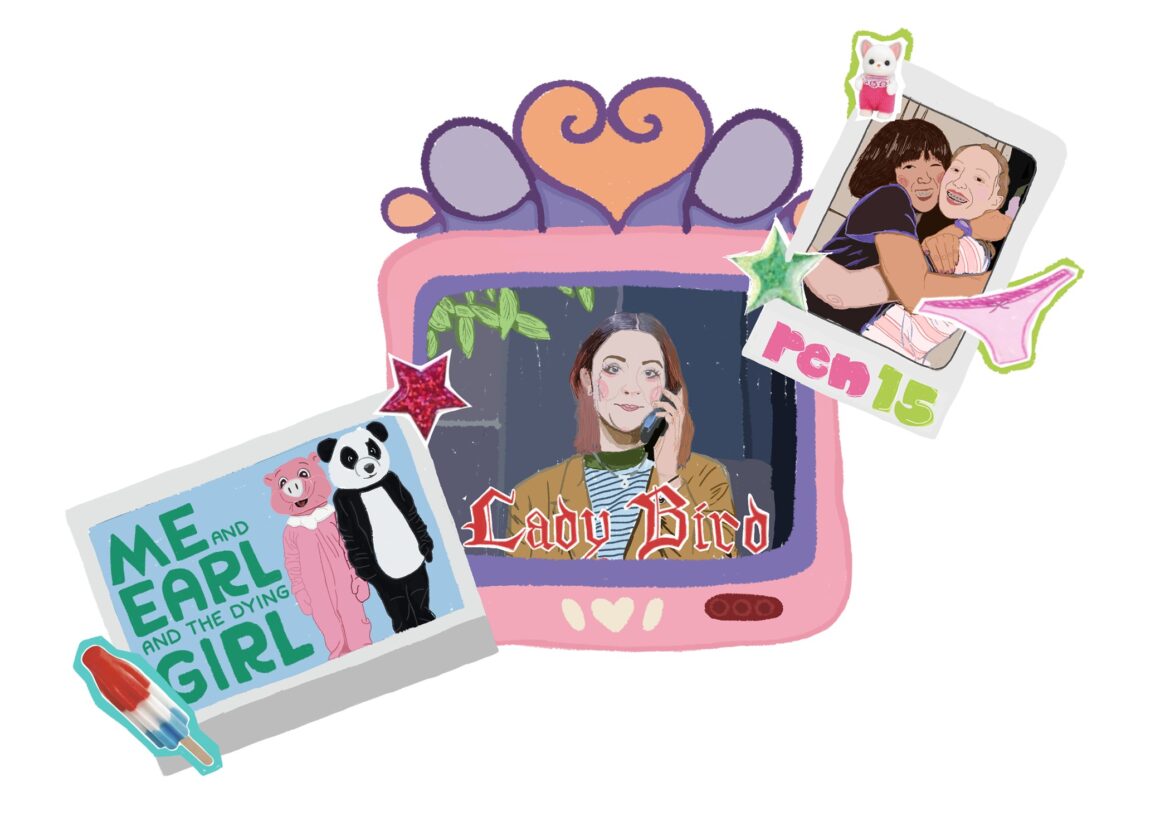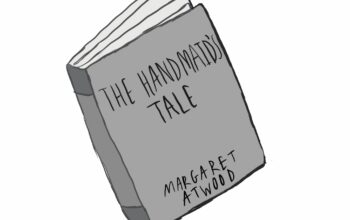Graphic By: Camila Solorzano
What makes a coming-of-age film good at portraying adolescence
Adolescence is many things; it’s fizzing anxiety and tears masked behind smiles, wrapped up in a deceiving ribbon of bittersweet regret. “Coming-of-age” media and content attempt to capture these turbulent experiences in hour-long spectacles.
Coming-of-age movies are a delicate balancing act, much like the period of life they attempt to replicate. They can come off as tone-deaf or shallow if the creatives behind them aren’t careful. So, how does one make a coming-of-age movie that is relatable, in-touch, and emotionally charged all at once? How can one attempt to sum up a period that feels so excruciatingly long in a couple of hours?
Immersing the viewer in the narrative as much as possible is key to a coming-of-age piece that realistically represents adolescence. Camera angles and film
techniques play a role in effectively drawing the audience
into the story and can make the intentional choices behind the film stretch a lot further.
Close-ups, for instance, give the audience an intimate look into the character’s emotions and catch details that wide shots would miss. In contrast, cut-aways and push-ins show delayed action and synchronicity with the character.
Great coming-of-age media typically contains a protagonist who defies societal expectations and forms a distinct sense of self, engages in internal dialogue, and has a solid developmental character arc. Often when the main character is a girl, their story line is accompanied by feminist undertones.
Coming-of-age cinemedia also puts extra emphasis on the relationships and social dynamics attached to the protagonist. Successful films portray this with subtlety and nuance that is relatable to viewers, instead of feeling like an adult’s interpretation of a teenage mind and its social landscape.
Films like “Lady Bird” and “Me, Earl and the Dying Girl” are clear examples of this. Both center realistic relationship dynamics such as strained parent-teen relationships and unlikely friendships.
It’s also important to center relatable topics that can be explored with depth. Young people don’t just want to see their struggles reflected back to them, they want to see characters wrestle in a way that provides them with helpful insight and validates the complex nature of their emotions. “The Perks of Being A Wallflower” shines a light on mental health, trauma, and toxic masculinity, while other media build from a humorous premise, followed by a deeper dive into topics such as racism, divorce, bullying, dysfunctional families, teen pregnancy, and isolation. Themes like these are displayed in shows like “Gilmore Girls” and “PEN15”.
“PEN15” features the 30-year-old actresses Maya Erskine and Anna Konkle portraying characters inspired by their 13-year-old selves. As the two stand in the midst of swarming middle school halls surrounded by their peers, played by actual teenagers, it becomes a metaphor for how the two felt they stood out, not only in physical appearance, but in their interests and path towards adolescence. Close-up camera angles accentuate this effect, giving the audience deeper insight in a personal viewing that handles girlhood with tenderness and harshness.
“PEN15” doesn’t shy away from the awkward silences or the jealous fits – because in real life, there are no jump cuts. The show captures that classic middle-school awkwardness, not being afraid to openly talk about puberty, friendships, and all the less than pretty parts of being a preteen.
Captured in glimpses and glances in mirrors, “Lady Bird” is the epitome of memory in film, exactly as director Greta Gerwig intended. It’s 2002, and all 17-year-old protagonist, Lady Bird, wants is to leave Sacramento. Her troubled relationship with her mother provides a refreshingly realistic take on parent-teen relationships in the media– there are fights, angry tears, and tender moments. The shots are not fancy or elaborate, they are shot “over the shoulder” and retain a grainy, faded quality.
When Lady Bird, or Christine, is around “the cool kids,” the screen takes on a blue-ish stylistic tone, as if stripped of personality, and when in her own “world”, it blooms with warmth in the form of comforting yellows and cozy shades. Color, as represented here, can clearly represent the growth into adulthood, as it’s often subtly incorporated and subconsciously interpreted by viewers. Here, it helps to define Christine’s comfort in the world and with herself. The Queen’s Journal said that “Lady Bird” is “arguably one of the first to capture the essence of teenagedom.”
“Me, Earl and the Dying Girl” is deceiving. It is visually a bright and teen-targeted movie with jokes tucked in unsuspecting places. Clever camerawork places the viewer inside the protagonist’s mind which reveals the heavier reality of the movie. Greg Gaines, a sarcastic, unbothered high schooler, sees the world in terms of categories, but ironically doesn’t fit into one himself. This is demonstrated by well-framed shots with lines running either horizontally or vertically; everything has its place, and is squarely socked away. His speedy thoughts are illustrated through flitting camerawork, as he deliberately avoids his worries and concerns about the future.
Viewers are let inside Greg’s mind in a way that couldn’t have reached the audience simply through dialogue. The movie explores common teenage experiences such as first-time experiences with death and
struggling to make friends in a way that feels approachable and realistic. Moments that may have come off as shallow are instead described by New York Times media critic A.O Scott as being “handled with humor and graceful realism,” and “thoughtful and assured in a way that lingers.”
These films hold power. Certain scenes have been engraved in the way young people view their “teenage dream.” “Perks of Being a Wallflower” is an exceptional demonstration of this. What is described as the “tunnel scene” in the movie features Emma Watsons’ character Sam having what she describes as her last moments of freedom before college. This scene in the tunnel has now become an iconic moment in coming-of-age film history that many youth cite as being the epiphany of teen freedom. The main character, Charlie famously voices over this scene saying, “And in this moment I swear, we are infinite.”
When polled, RHS students described coming-of-age movies with phrases like “make light of hard situations,” and “relatable to teens watching them.”
Multiple students referenced “PEN15”, which speaks to how realistic and relatable teens find the show; it’s unafraid and messy and real, unlike some other shows that romanticize the difficulties of adolescence.
Even so, shows like “Euphoria” received praise for amplifying some of the dark sides of teenhood. NPR describes “Euphoria” as being “universally tragic and emotional” while also being a “parent’s worst nightmare.”
Even when characters like Rue, Cassie, and Kat make terrible decisions over and over again related to drug use, interpersonal violence, and relationships, producer Sam Levinson manages to keep the audience rooting for them. Dramatic cinematography reminds viewers how big and overwhelming the world around these teens is, maintaining an underlying sense of innocence even while the characters stray far from their childhood selves.
There will never be the perfect coming-of-age movie. No single film will be able to pertain to everyone all of the time, yet the genre maintains such relevance in this world of modern media.
Coming-of-age films provide an opportunity to discuss complex ideas that are honest to what teens are actually experiencing. There is one thing that never changes: there’ll always be a hunger for the validation and reassurance these movies provide, no matter the generation, no matter the person.
Even if you know that other teens are going through similar experiences, there is something emotional about seeing them play out on the silver screen– almost like it’s the world’s way of saying, “I see you.”



